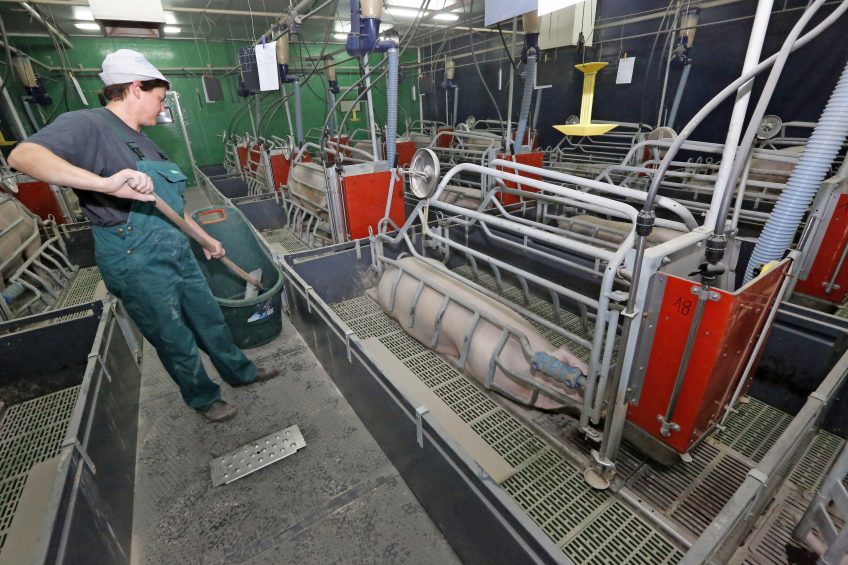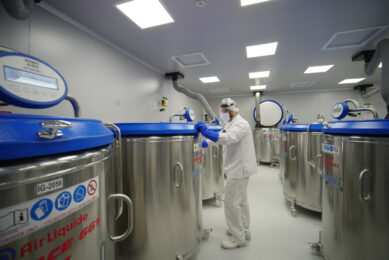Small country, high pig health status

A few years ago, Armand and Carine Kreins from Luxembourg built an entirely new sow farm, paying a lot of attention to health. Producing in this tiny state has its advantages, but the real difference is being made inside the pig houses.
Luxembourg is one of the smallest countries in Europe and that also holds true for its pig industry. The entire country has about 6,000 sows on roughly 50 farms. In total, every year, only 120,000 pigs are slaughtered. With 170 sows and 1,400 finisher pigs, the farm of Armand and Carine Kreins-Aendekerk can be considered to be of average size.
Mr Kreins acquired the farm in 1995 when there were only finisher pigs on the site. For years he combined that work with being active in a breeding organisation. In 2008 he invested in a first house for 120 sows. A few years later he expanded to the current amount and a separate place was built for the finishers. He explains, “Luxembourg does not have any professional piglet trade, so we had to finish them ourselves.”
He started with a greenfield location in an undulating countryside in the north of Luxembourg. When designing his pig houses Mr Kreins used his experiences from his previous job – he used foreign materials to have his farm constructed: they came from the Netherlands, Belgium, Germany, France, Luxembourg – and even Canada.
Closed structures
The limited size of Luxembourg’s pig inventory has its pros and cons. The relative absence of pig farms means that in general this is good for a farm’s health status – this also counts for the Kreins family. PRRS is hardly a problem, which is partly due to the small population and closed farm structures. That makes it easy for the Kreins family to keep the virus out.

A small sized population also comes with disadvantages. The country hardly knows a pig infrastructure and for almost everything it is dependent on farms from the surrounding countries Belgium, Germany and France. A remarkable pig house made of wood and more than one roof was not only by choice, but also after having consulted both the local authorities as well as the neighbours.
Kreins says, “In itself it is not difficult to obtain a building permit, but it is considered very important that the building fits in its surroundings.” In other words: this leads to an extra price during construction and can lead to a suboptimal usage of the pig house.
Keeping the status
A high health was something that was on the minds of the owners when the farm was started up. The initial high health status has never been lost ever since. The owners never bring anything into the farm, other than semen. In addition, there is a very strict hygiene protocol in which nothing and nobody can enter the pig houses unseen. Worth mentioning in biosecurity is the rodent and animal protection: netting avoids the entrance of birds; in addition in the outside wall a H-profile is being made, which causes mice or rats to run into a dead end – they can’t enter the pig houses. Mr Kreins says, “That way we don’t need any measures against rodents inside the pig houses.”

Inside the farm management revolves around the use of groups in an all-in/all-out system. In a five-week-system, he has four groups of 42 sows rotating through the farm. All farm sections have been adjusted to that system. Even in the finishing section, these groups stick together as much as possible.
The constant and structural attention to health has resulted in great performance. Growth and feed conversion are good, but especially mortality figures are impressive: for three years, this has been around 0.5-0.8%. Having said that, there are also production rounds with 0% mortality.
Moving pigs around
Keeping a keen eye on health issues happens throughout the entire farm. The entrepreneurs thought deeply about how to construct the farm. Gestating sows are in free access stalls and can stretch their legs in a large pen with straw. Admittedly, the system does require labour but the farmers have chosen the system due to low building costs, the absence of a manure pit and higher animal welfare. The system allows the keeping of all gestating sows in one dynamic group.

In the lactation area, high-pH chalk (Desical) is spread around inside the pens. After farrowing, the farmers choose to use chalk with chloramine, which creates less dust. The chalk policy is to add to dryer pens in which pathogens cannot survive as easily.
Every day, manure is being removed from the farrowing pens and because of manure pits underneath the sows there is minimum of manure inside the pig house. Kreins says, “Less ammonia is better for the climate as well as for health.”
Inside the climate control system there is a heat exchanger, so incoming air will always be conditioned. This reduces energy costs – they amount to € 70 per sow per year, including the finishing pigs.

Worth mentioning is the finisher management. To be able to use the space optimally, the animals are moved around more than once. After the grower phase until 18-20 kg, the pigs will go to a pre-finisher house. They will stay there until they reach a weight of 35 kg, next step is a pig house where they stay until the weight of 60 kg. Last but not least they go to a final finishing house where the pigs stay until a weight of 120 kg. Mr Kreins adds, “We do this to look at lower building costs.” By moving the pigs around, the space is always used efficiently. As of weaning, the piglets will stay in the same group with each other. Groups can be reduced in size, but mixing doesn’t happen.

Kreins Farm, Luxembourg
Kreins Farm, located in Hupperdange, Luxembourg, is owned by Armand Kreins, 55, and Carine Kreins-Aendekerk, 50. The family farm has 170 sows, 1,400 finisher pigs and 65 ha of arable farming. The sows are bred on-farm, using Pen ar Lan and Large White sows. The sire line consists of German-Austrian Piétrain. Finishers are being slaughtered at the slaughterhouse in Ettelbruck. The farm has a high health status and is free from e.g. PRRS, mycoplasma, App and influenza. The sows have been producing 13.9 live piglets/litter (2016). The finishers have a meat percentage of 61.4%.
Nutrition requirements
The farmers supply their pigs to a label called ‘Marque Nationale’, a Luxembourg brand. The pigs have to have been finished in Luxembourg and have to have had a slaughterweight of 96 kg on average, because of the production of dry hams. There is a set of additional requirements for nutrition, e.g. a minimum of 60% of grains and the addition of specific fatty acids. Mr Kreins estimates that 80-90% of all pigs in Luxembourg are produced for this specific label. There are, however, strong ties to Germany. German meat prices are leading for establishing meat prices in Luxembourg and some meat is even being sold across the border.
Finishing pigs for the Luxembourg label means that pigs need to be getting relatively heavy with a high meat percentage. Gilts are being fattened until a weight of about 100 kg slaughterweight; boars weigh about 90 kg slaughterweight.

Apart from the choice of the right breed, also nutrition is a major aspect to achieve good results. Every group of finishers thus receives a ‘personal’ ration, with emphasis on the right amino acids and the energy levels in the feed. Piglets and finishers can receive both dry feed as well as liquid feed from their troughs, depending on feed intake as well as health status.
At the moment of the visit, the farmers received about € 1.60 per kg slaughterweight. With a cost price of € 1.70/kg, including interest and private spending, the farm is losing money. Without a remuneration for labour, production price is around € 1.45 per kg. The owners hope to achieve a sufficient amount of money with a continuous focus on technical results as well as slaughter quality.











